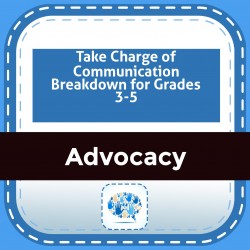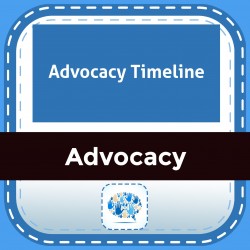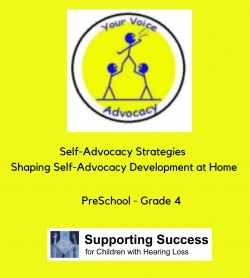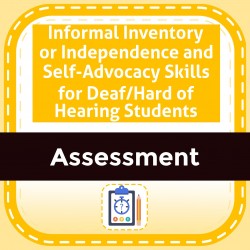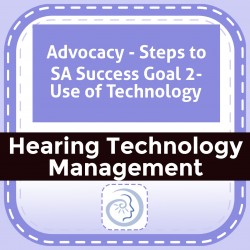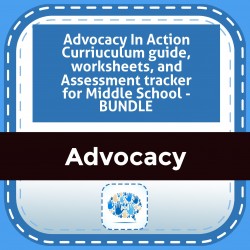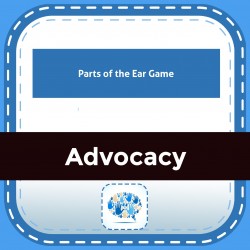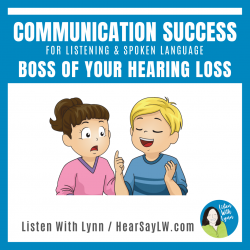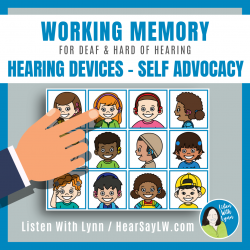Ability Levels
Categories
Resource Types
Age/Grade Range
CCSS
Anchor Standard
Speaking & Listening
Language
Reading
Take Charge of Communication Breakdown for Grades 3-5
$ 8
A ten-page comic-style book (in color & grayscale) defines communication and communication breakdown. Examples are shown as interactions between two boys: Luke and Ricardo. A teacher acts as narrator
...
and discusses three tools for repairing communication breakdown: signaling the breakdown, asking for repetition and repeating what was heard. The boys use each tool in responding to a single CBd event. A glossary is provided at the end of the book. Materials also include a graphic organizer, 8 discussion-starter cards, 6 review cards and 5 comprehension questions for assessment. Teacher notes explain how the lesson materials can be used in face-to-face lesson or on a digital platform.
Advocacy Timeline
$ 195
This fillable sheet is a great tool to use as practice to create awareness about specific accommodations needed at an event. Students gather information about the event type, location, and activity i
...
n order to determine the best access for them.
Self-Advocacy Strategies - Shaping Self-Advocacy Development at Home
$ 195
This handout includes useful tips for parents about developing a child's self-advocacy when it comes to their hearing devices, communication needs, & listening challenges. Includes 25 point Guide wit
...
h suggestions for sequence of skill attainment. PK-Grade 4.
Informal Inventory or Independence and Self-Advocacy Skills for Deaf/Hard of Hearing Students
$ 0
Teacher Checklist or DHH Specialist rating of independence as a student, self-advocacy, peer interaction, community, use of an interpreter. Scoring identifies level of advocacy and independence. Appro
...
priate for Deaf students and hard of hearing.
Advocacy - Steps to SA Success Goal 2- Use of Technology
$ 195
Students learn vocabulary associated with hearing technology and how to take care of it. Use this fillable worksheet with students to problem-solve what is good/bad for devices.
Advocacy In Action Curriuculum guide, worksheets, and Assessment tracker for Middle School - BUNDLE
$ 1695
Complete curriculum guidance, fillable sheets, activities and scenarios for instruction in understanding hearing loss (in themselves and other role models), assistive devices, and social awareness si
...
tuations. Also includes a a pre and post assessment skills tracker that can be used to determine strengths and needs, track skill acquisition, and create goals and objectives. Includes items 0527-0531, 0535, 0539, 0479, 0477
Elephant in the Room (iBook)
$ 6
Skyler has a hearing loss. And he doesn’t feel much like talking today. No wonder—he keeps missing what his parents and siblings have to say, and it’s frustrating. Skyler’s little sister, Maizy, tags
...
y, tags along on his morning routine and, with the help of her special friend, we learn that it takes more than hearing aids to help Skyler feel like talking again.This 35-page full color children’s book by Audiologist Jim Bombicino provides avenues for discussion and building vocabulary by highlighting the difficulties that students may face each day, including mishearing and misunderstanding information, the effect of background noise, and consequential frustration and confusion that can happen when the ease of daily communication is taken for granted by typically hearing persons. In this case, the story follows a young boy as he awakens and prepares for a typical school day.The e-book version includes audio of the text read by actors, while their voices are filtered to imitate how Skyler hears through his hearing aids! Listening situations include a speaker with added background noise, simultaneous speakers, a speaker talking too quickly, and mishearing words—all heard as they come through Skyler’s hearing devices. Perfect for helping teachers, families, and classmates understand what a hearing loss might be like. Finally put typically hearing adults and children in the shoes of the child with hearing loss!Please note: Compatible only with iPad and iOS devices. Free Author’s notes and discussion guide are available for download at Teacher Tools Takeout marketplace.How to Open ePub Files on Your iPad.Before trying to load the ePUB file make sure you have downloaded and installed iBook app from Apple’s app store.Directly on the iPAD or Iphone (recommended)1. Make sure the free iBooks app is on your iPad.2. Follow the link from Safari to reach the ePub document. This means either accessing your email to find the attached file, or going to our website to download the file with an access code.3. Select “Open in iBooks” on the iPad/iPhone4. The eBook will open and be added to your iBooks collection.5. From now on, you can open the ePub document from the iBooks app on your iPad/iPhone.From PC to iPAD1. Make sure the free iBooks app is on your iPad.2. Make sure the free Itunes app is on your PC. Open iTunes.3. Find the ePub file on your computer by accessing email or visiting website where purchased/obtained.4. Drag and drop the ePub file onto your Library in iTunes on your computer.5. Connect your iPad to your computer.6. Check under the “Books” tab in iTunes to be sure this ePub is selected for syncing7. Then sync.8. The ePub document is added to your iBooks collection inside the iBooks app.9. From now on, you can open the ePub document from the iBooks app on your iPad.Directly on PCHow to read Open EPUB or Open PDF e-books on a computer1. Download the free Adobe Digital Editions: https://www.adobe.com/solutions/ebook/digital-editions/download.html2. Open Adobe Digital Editions (ADE) on your Windows or Mac computer.3. Go to File > Add to Library.4. Find the saved EPUB or PDF file on your computer. By default, files are saved to your computer’s “Downloads” folder.5. Double-click an e-book to start reading, or follow these steps to transfer it to an e-reader.
Parts of the Ear Game
$ 5
This is a fun digital learning activity for a student to review the 3 parts of the ear. The learner identifies the function of each part, what is in each part and uses a diagram to identify parts of t
...
he ear.There are very few digital learning activities available today. Advocacy practice for students with hearing loss includes learning about hearing. As students begin to learn how they ear, identifying the 3 parts of the ear is a first step. They need lots of practice labeling different parts of the ear and identifying how they help with hearing. Learning Objective:1. The student will be able to identify functions of the 3 parts of the ear. 2. Given a diagram, the student will label the part of the ear.
Self-Advocacy Tips for Communication Success
$ 3
Ten self-advocacy tips for communication success for children that are deaf and hard of hearing who use listening and spoken language.
...
Hearing Devices - Self Advocacy Working Memory
$ 2
If you have students who are deaf and hard of hearing that need help with auditory working memory, executive functioning, and following directions, this Listening Finger Walk is a must-have! It builds
...
lds vocabulary about types of hearing loss and hearing devices. It boosts confidence and helps children feel good about their own hearing technology. It's fun for the kids and a simple no-prep resource for you. Just open the PDF on your screen or print it and go!The colorful playing board features 16 children wearing hearing devices like hearing aids, cochlear implants, and bone-anchored hearing systems. You can target vocabulary like unilateral, bilateral, behind-the-ear, in-the-ear, earmolds, processor, headpiece, magnet, coil, microphone, and more.This Listening Finger Walk:➼ helps build listening skills and working memory by allowing kids to work with auditory information without losing track of what they're doing.➼ targets vocabulary, descriptive skills, spoken language, and communication skills.➼ has three rounds that each increase in auditory complexity.Includes:✧ A Hearing technology or devices theme for therapy sessions or school lessons✧ Listening and Spoken Language Tips✧ Print Version: Easy print and go!✧ Digital Version No Prep Ready to screen sharePlease Note: This activity and the Positive Self-Concept Auditory Learning Games contain similar images of the same children. The resources both target self-advocacy but have different auditory and language-based goals. You will want both resources you will want in your Summer Toolbox.◈ ◈ ◈ ◈ ◈ ◈ ◈ ◈ ◈ ◈ ◈ ◈ ◈ ◈ ◈ ◈ ◈ ◈ ◈ ◈ ◈ ◈ ◈ ◈ ◈ ◈ ◈ ◈ ◈ ◈ CUSTOMER TIPS:➼ Questions? EMAIL ME before purchasing this resource or anytime later♥ ♥ ♥ Sign-up HERE for the Listen With Lynn Emails♥ Let’s Connect:InstagramFacebookKeep up your excellent work. I am blessed to help along the way.Thanks so much!Lynn Wood
 Your browser is out of date. For best experience switch to latest updated Browser.
Your browser is out of date. For best experience switch to latest updated Browser.
 Get Chrome
Get Chrome Get Edge
Get Edge Get Firefox
Get Firefox